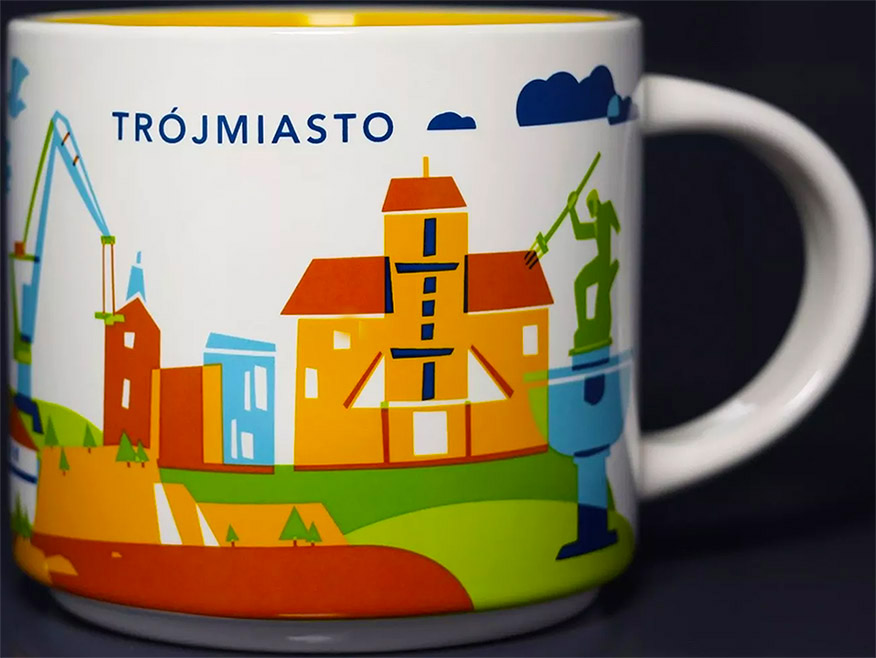
You Are Here – Trójmiasto
You Are Here – Trójmiasto is a mug for a metropolitan area in northern Poland that comprises three cities: Gdańsk, Gdynia, and Sopot, also known as Tricity or Tri-City. Its rich history dates back to the medieval period, with Gdańsk emerging as a significant trade center in the Hanseatic League during the 14th century. The area played a pivotal role in maritime commerce, with its strategic location on the Baltic Sea facilitating trade routes that connected various European markets. Gdańsk’s tumultuous history is marked by various conflicts, including its destruction during World War II, which left deep scars on the city and its inhabitants. Following the war, Gdańsk became a symbol of resistance against communism, notably as the birthplace of the Solidarity movement in the 1980s, which eventually contributed to the fall of communism in Poland. Meanwhile, Gdynia, developed in the 20th century, transformed from a small fishing village into a bustling port city, reflecting Poland’s aspirations for maritime independence. Today, Trójmiasto stands as a vibrant testament to its historical significance, combining rich cultural heritage with modern development.
Here are some design elements from the You Are Here Trójmiasto mug that I was able to recognize:
– The Brama Żuraw (Crane) is a historic symbol of Gdańsk, Poland, and serves as a prominent landmark along the Motława River. Originally built in the 15th century, it functioned as a port crane, enabling the loading and unloading of heavy cargo from ships, which was crucial for the city’s thriving maritime trade. The structure is notable for its unique design, featuring a wooden superstructure that was raised and lowered by a system of counterweights. Over the centuries, the Żuraw has witnessed significant events, including the Hanseatic League’s dominance and the devastation of World War II. Today, it stands as a museum, showcasing Gdańsk’s rich maritime history and architectural heritage, making it a must-visit for tourists and history enthusiasts alike.
– A boat tour along the Motława River is a fantastic way to see Gdańsk’s Old Town. As you float down the river, you’ll enjoy beautiful views of famous sights like the Żuraw and the colorful old buildings that showcase the city’s history. The ride is peaceful, with the gentle sound of water making it a relaxing experience. Guides share interesting stories about Gdańsk, adding to the fun. Whether at sunset or during the day, a boat tour offers a memorable look at the charm of Gdańsk’s Old Town.
– Neptune’s Fountain, located in the heart of Gdańsk’s Long Market, is a striking symbol of the city’s maritime heritage. Completed in 1633, the fountain features a bronze statue of Neptune, the Roman god of the sea, holding a trident and surrounded by intricate sculptures of sea creatures. Originally commissioned to celebrate the Treaty of Oliva, it reflects Gdańsk’s historical significance as a major port city. Over the years, the fountain has undergone several renovations, including a full restoration in 2012, and remains a popular gathering spot for both locals and tourists, embodying the rich cultural history of Gdańsk.
– Sopot Pier, or Molo w Sopocie, is the longest wooden pier in Europe, stretching approximately 1700 feet into the Baltic Sea. Located in the picturesque seaside town of Sopot, Poland, the pier is a beloved destination for both tourists and locals, offering stunning views of the coastline and the vibrant beach atmosphere. Visitors can stroll along the pier, enjoy fresh seafood at nearby restaurants, or simply relax while watching the waves. The pier also serves as a focal point for various events and festivals, making it a lively hub of activity and a must-visit spot for anyone exploring the beautiful Tri-City area.
– The Port of Gdynia, located on the Baltic Sea in Poland, is one of the country’s main seaports and a vital hub for maritime trade. Established in the early 20th century, the port has grown to become a key player in the region’s economy, handling a wide range of cargo, including containers, bulk goods, and vehicles. Its modern infrastructure and deep-water facilities allow it to accommodate large vessels, making it an essential gateway for international shipping. In addition to commercial activities, the port also serves as a base for passenger ferries and offers stunning views of the waterfront, attracting visitors who appreciate its blend of industrial significance and maritime charm.



































































